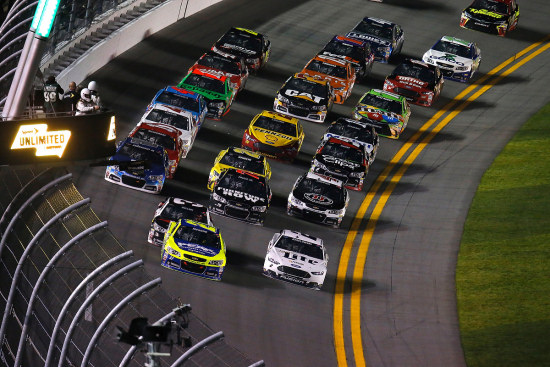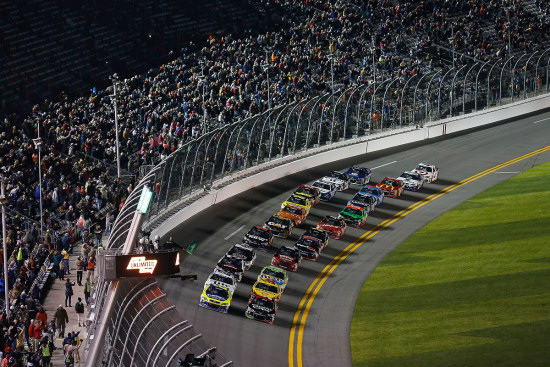The Way It Is/ NASCAR's increasingly collaborative waysby Gordon Kirby |
 You have to give NASCAR credit. Without doubt, the organization is way ahead of Formula 1 and IndyCar in how it works with its teams and manufacturers in adjusting and refining its aerodynamic and technical packages to suit different tracks. It's a truly collaborative effort between the sanctioning body and its teams.
You have to give NASCAR credit. Without doubt, the organization is way ahead of Formula 1 and IndyCar in how it works with its teams and manufacturers in adjusting and refining its aerodynamic and technical packages to suit different tracks. It's a truly collaborative effort between the sanctioning body and its teams.
This year NASCAR is experimenting with some changes in the middle of the season trying new aero packages at Kentucky the weekend before last and at Indianapolis next weekend and Michigan next month. Sixty employees, including series directors, engineers and post-race inspection people, work at NASCAR's R&D center in Charlotte. Many of them are focused on the business of aero packages. "It's a big task," remarks NASCAR's vice president of competition Robin Pemberton. "We have a lot of people at the R&D center who are studying it and working hard on it trying to capitalize on the right opportunities to do the right things for everybody. "More times than not," Pemberton adds, "the things that we do raise questions on where you've been and where you're going. The path that you think you chose at first may not be the path that you take once you start to learn."  © Mike Levitt/LAT USA "Sometimes it makes me laugh," he observed, "when race fans say, 'Man, the racing back in the '70s or '80s, or whatever it might have been, was awesome. It's so much fun and so cool to watch those highlight reels.' "Really," Busch added, "the highlight reels are cool but the races were boring. There were three cars on the lead lap. Now you've got thirty cars every single week that are on the lead lap. I don't know if having three cars on the lead lap would be more exciting to these fans or not." That said, Busch sang a song of praise for NASCAR. "I believe NASCAR has given every effort to put a better product out there on the race track for the fans," Kyle said. "I feel NASCAR has done a really good job of trying some different things. To do it in the middle of the season, I don't know that they've really done that before. It just shows that we all have a job to do, NASCAR included. "The Kentucky race I felt like it was an A plus. Besides all being closer together, I thought the excitement around the race was pretty good. Of course, on restarts you're always going to have cars around each other, but they soon single-file out, even at short tracks. The less downforce at Kentucky was good. I felt positive about it. Our team ran well, so maybe that's why." Like most people, Busch isn't sure what to expect from the new aero packages to be used at Indianapolis next week and Michigan a few weeks later. "The other aero packages that we're going to run at Indy and Michigan are going to be different. We're not sure what to expect. A couple of guys tested last week, but we'll see how it all pans out and if it produces exactly what NASCAR is looking for. I'm not 100 per cent certain it will, but I'm not always the most positive person." Busch believes in customizing aero packages for individual tracks but questions the added costs for the teams. "I think different packages for different tracks is not such a bad thing," he commented. "I do agree with Tony Stewart that someone's got to help these race teams with the costs of all these different packages 'though. It's not cheap, especially with four-car teams. We all certainly didn't budget for different aero packages at the beginning of the year and now we've got to rework our budgets to fit that in. So it gets a little challenging sometimes." Roush-Fenway Ford driver Greg Biffle agrees with Toyota man Busch and also expressed his enthusiasm for reducing downforce. "I'm a fan of the low downforce," Biffle declared. "Every time we've had a shorter spoiler or less spoiler the cars get to sliding around a little bit. They're not as fast in the corner. It's just better racing and it allows us to pass. I applaud NASCAR for what they're doing and to change it up a little bit and give us an opportunity to see what it does."  © Mike Levitt/LAT USA "I think having different packages for different tracks is a bold idea," he continued. "The way the cars are now with the splitter and the spoiler it gives us the opportunity to change the package around and that's a positive. "I'm game for all the changes they're doing. Kentucky was probably one of the best races we've had in a long time from a driver's point of view because we were able to do things we couldn't do with the car before. You weren't stuck behind the guy. It seemed like it was a step in the right direction because the effect of the car in front of you was less and the speed in the corner was down a little bit so you could move around from lane to lane. I thought it was much better." Biffle also ruminated about the package for next weekend's Brickyard 400 at Indianapolis. "I'm going to reserve my opinion until afterwards because I don't think any of us know how it's gonna act," he remarked. "I think it's going to be exciting. What's going to be the determining factor is that if you take four cars and put them single-file, can you get enough of a run or be close enough to the leader in dirty air with the big spoiler that you can get enough of a run around the corner for it to pay off by the end of the straightaway? "We all know Indy has been a drafting race track. Under any rules package back to when I first started going there, if you couldn't get by the guy in front you were going to get passed by the guy behind you because the minute you pulled out and got beside him on the straightaway it punched a huge hole in the air so the guy behind you passed both of you. "We've seen that happen all along," Biffle added. "So now with this new package if we see guys get side-by-side it's gonna be a huge draft. So we'll have to wait and see how that transpires." Robin Pemberton provided NASCAR's perspective. "I think the important thing is we're moving," Pemberton said. "We're evaluating and looking at opportunities. We race at 23 different facilities and they're all unique. The good news is we're looking and trying to put our best foot forward and do what's best for the fans and for the race teams to put on the best show. "It's not unlike anything else. It has its challenges because we're so busy all of the time. It's a collaborative effort that's been here for the better part of the last four or five years. It's gone from being a collaborative effort among the manufacturers and teams to get the new Gen 6 cars up and running to what we're doing now which is working on the different aero packages and whatever else is required to make good racing. The co-operation between everybody is at an all-time high in my opinion." Meanwhile, it's nice for fans and media to talk about banning or putting limits on wind tunnel use and time, but that's something that may be impossible to do in today's world where so much of the racing industry is dedicated to aerodynamic research and development. "It's very hard to do because everybody has their own way of doing things," Pemberton observed. "You also have guys who live in the wind tunnel and you have guys who live in a world of CFD. There are a lot of good wind tunnels and a lot of good opportunities for people to work on their cars. There are plenty of good facilities and people involved in the business for all our teams. I think it's impossible to try to corral all that among a bunch of independent contractors."  © Mike Levitt/LAT USA "The K&N bodies look really nice and the teams have been racing them and working on them," Pemberton said. "The reviews so far have been pretty good. So we're putting our foot into the water and see where it may lead us. We're driven by the economy as much as anything. "When we started the Gen 6 program the early test mules were easier to build out of carbon and they were one-piece carbon bodies. They were beautiful, but at that time the economics weren't there for us. But now we're looking at it. We're starting with the smaller series and working our way up." To an outsider who's covered NASCAR casually for more than forty years, it appears that the people in Daytona Beach and Charlotte have built and fostered a much healthier and more effective relationship with their teams than any other sanctioning body. One of NASCAR's greatest strengths is that it is very sure and very clear about its philosophy and way of doing business. In that regard, the rest of the sport has a lot to learn from them. |
|
Auto Racing ~ Gordon Kirby
Copyright ~ All Rights Reserved |
